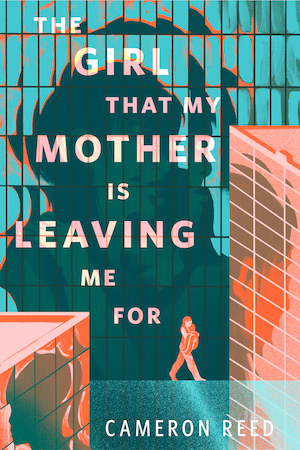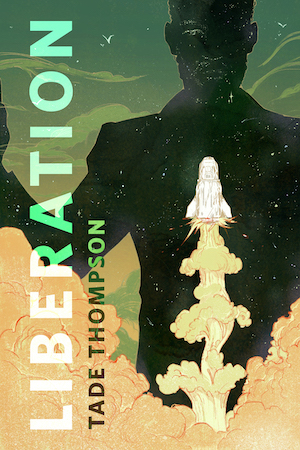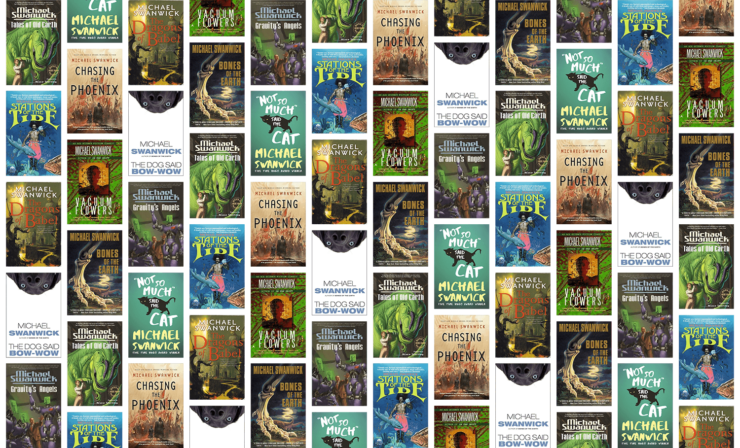In the film Being John Malkovich (1999) it becomes possible to inhabit the actor’s mind by going up to the 7½th floor of the Mertin-Flemmer Building, opening a small hidden door and crawling through a tunnel. Fortunately for me, the wonders of modern video calling made it much easier to pick Michael Swanwick’s brain.
Over the course of about a year and a half, I asked him endless questions about his fiction, his impressions of the genre and its key players, and his thoughts on writing. With saintly patience and notebooks brimming with useful information, he indulged me as I proceeded to work my way through all of his short stories in chronological order. I hope that the result of our conversations, Being Michael Swanwick, will not only act as a guide to a fantastic career, but also be of interest to those curious about genre history and the craft of storytelling.
In 1986 Swanwick published A User’s Guide to the Postmoderns. Since then, he himself has been a productive writer in every prominent market of the last four decades—including being a prolific contributor to this space— so I thought it would be fun to put together recommendations of his fiction for anyone looking to explore Swanwick’s large, possibly even intimidating, body of work.
There’s a ton of quality material to choose from. For instance, look at the awards recognition. With a combined total 40 nominations for the Hugo (24) and Nebula Awards (16), including 5 Hugo wins and 1 Nebula win, plus a long roster of other distinguished honors (World Fantasy Award, Theodore Sturgeon Memorial Award, Locus Award, Asimov’s Readers Poll, and so on) just going through the award-nominated works would be a considerable enterprise. Of course, not all nominations are for separate items, but still, it’s a lengthy list. Yet there are many fascinating pieces that had a less splashy reception and are well worth tracking down.
What follows are some of my personal favorites, a selection of ten short stories and five novels—with a couple of bonus items at the very end—that I think show Swanwick at the peak of his powers.
Short Stories
As I worked my way through Michael’s bibliography in preparation for our discussions, I asterisked the stories that I found warranted multiple re-reads. This curated list begins with “Ginungagap” (1980), from the start of his career, and goes through all the way to the recent “Huginn and Muninn—and What Came After” (2021). Below is my sub-selection of ten tales from this list of outstanding pieces.
Some of my choices, like “The Edge of the World” (1989), “Slow Life” (2002), and “From Babel’s Fall’n Glory We Fled…” (2008) were popular upon publication, and their inclusion in my list will likely surprise few readers. On the other hand, entries like “Mother Grasshopper” (1997) or “The Man in Grey” (2011) are perhaps less obvious, but nevertheless resonated deeply with me.
No matter which stories sing for you—and believe me, a number of them will—Swanwick’s is a remarkable achievement: over forty years of storytelling excellence sustained through a myriad of narrative structures, voices, and styles.
- “The Man Who Met Picasso” (1982)
An enchanting yarn that manages to successfully combine the club story, the secret shop story, the secret history, and the coming-of-age story. Come for the art; stay for the charm.
Opening line: “In another time, another place, the shop could have been a magician’s lair.”
- “The Edge of the World” (1989)
Ah, the romance, woes, and angst of adolescent entanglements. This story takes place in an alternate Earth and follows Donna, Piggy, and Russ as they descend a staircase into an infinite void. Rarely does the external world so perfectly reflect the stakes we sometimes feel in our invisible, inner selves. Pathos, for sure—catharsis, you decide.
Opening line: “The day that Donna and Piggy and Russ went to see the Edge of the World was a hot one.”
- “The Changeling’s Tale” (1994)
This is Swanwick’s autobiographical tribute to J.R.R. Tolkien, a meditative fantasy whose world includes giants and necromantic beasts but whose core is a quiescent, tenderly rendered search for lost time. As Swanwick said in our conversation: “When I was young, I ran away with the elves, like the young tavern boy abducted in the story, and I became a writer.”
Opening line: “Fill the pipe again.”
- “Mother Grasshopper” (1997)
Swanwick wrote this mind-bending story after reading Stephen King’s The Gunslinger, and included a few acknowledgments of his inspiration in the text. What if people lived inordinately long lives in a civilization thriving on a grasshopper that travels through space, and one day a wanderer showed up with the gift of death and you became his apprentice? And that’s just the beginning….
Opening line: “In the Year One, we came in an armada of a million spacecraft to settle upon, colonize, and claim for our homeland this giant grasshopper on which we now dwell.”
- “Slow Life” (2002)
A member of the first research team on Titan faces great peril, which may be triggering hallucinations—or may have perhaps catalyzed the greatest discovery in the history of humanity. Swanwick’s Hugo-winning story is hard SF at its most compelling and literate, conveying a wealth of scientific detail through elegant prose while also not skimping on character development. It has the most visually immersive opening sequence of any Swanwick story, as we follow a raindrop plummeting through the various layers of Titan’s atmosphere.
Opening line: “The raindrop began forming ninety kilometers above the surface of Titan.”
- “From Babel’s Fall’n Glory We Fled…” (2008)
A stimulating, heady blend of biology and economics in the service of complex, subtle worldbuilding and tough character decisions amid a classic first contact scenario. The story is narrated from the point of view of a sentient space suit named Rosamund. Thoroughly thought-provoking and exciting.
Opening line: “Imagine a cross between Byzantium and a termite mound.”
- “The Man in Grey” (2011)
Dark and sharply written; in the classic “what if reality is not what we think?” Twilight Zone mode, with a relatable character that keeps us grounded even as the world itself bubbles away. Martha Geissler is easy to feel sympathy for, and her journey proves a stepping stone to a far stranger “transient taste of being.” This is late-act Swanwick at his existential best.
Opening line: “There’s a rustling in the wings.”
- “The She-Wolf’s Hidden Grin” (2013)
Swanwick’s brilliant Gene Wolfe tribute story, a feminist inversion of “The Fifth Head of Cerberus” that stands completely on its own merits. I don’t want to say much more than that. Disturbing, and trafficking with themes of societal pressure and self-destruction, it purposefully carries the torch of ambiguity that characterizes Wolfe’s richest fiction.
Opening line: “When I was a girl my sister Susanna and I had to get up early whether we were rested or not.”
- “Starlight Express” (2017)
Beautifully juxtaposing a far future with an ancient Roman setting, this story deals in unrequited love, but even more so in the echoes and cultural mistranslations of love. The story is steeped in a kind of fin de siècle melancholy that through its science fictional elements becomes more of a fin de histoire vibe. With a nod to Hieronymus Bosch, and achieving wonderful verisimilitude—despite the inventiveness of the setting and technology—due to Swanwick’s own travels in Rome, it’s a gut-punch.
Opening line: “Flaminio the water carrier lived in the oldest part of the ancient city of Roma among the popolo minuto, the clerks and artisans and laborers and such who could afford no better.”
- “Huginn and Muninn—and What Came After” (2021)
Yes, I’m going to end on a downer; the original publication of this story in Asimov’s was preceded by a warning regarding its frank handling of suicide and despair. Through a powerful and visceral yet evocative fantasy, Swanwick enters into dialogue with James Tiptree Jr./Alice Sheldon. In Swanwick’s own words: “I wrote this story because Tiptree had published a story called ‘In Midst of Life,’ in which she was obviously picturing her own afterlife.”
Opening line: “Her name was Alyssa and nobody knew who she was.”
The above picks are non-series pieces, but I can’t pass up the chance to also mention Swanwick’s highly enjoyable Mongolian Wizard stories, available on this site, and the Darger and Surplus escapades, about which more below.
For those interested in Swanwick’s story collections, here are the four essential ones to look out for:
- Gravity’s Angels (1991)
- Tales of Old Earth (2000)
- The Dog Said Bow-Wow (2007)
- Not So Much Said the Cat (2016)
If you’re in the mood for a single-stop career retrospective rather than individual period-specific volumes, The Best of Michael Swanwick (2008) is the place to go.
In fact, Subterranean Press recently published its sequel, the substantial The Best of Michael Swanwick: Volume Two. It’s every bit as good as the first installment, and I’m pleased that in Being Michael Swanwick, which was submitted to the publisher before Volume Two was shaped, we discuss the stories contained therein.
Given the speed with which Michael publishes new work, and its consistent quality, I wouldn’t be surprised if the 2030s graced us with a third volume. Fortunately, science fiction has a reputation not only for prolific practitioners, but also long-lived ones. Here’s hoping!
Novels
As much as I love short fiction as a pathway to discovery, some readers prefer to jump in with novels. If you’re looking for longer works, here are five treats by Swanwick:
- Vacuum Flowers (1987)
“Colorful” and “inventive” are two adjectives Michael used when describing the novel in one of our chats; they certainly apply to this almost non-stop whirligig of wonders. John Clute wrote in Interzone:
Swanwick’s protagonist—Rebel Elizabeth Mudlark—has parachuted mysteriously into one of the corporation-dominated habitats that choke the solar system, and died. Recorded immediately, she soon piggybacks a persona bum, chipping into a complex power game amongst the gesellschaften (a cyberpunk word for Krupp), but before she can be terminated a deuteragonist more knowledgeable than she is befriends her, and inveigles her downwards to Earth…
This one has AI, memory swaps, corporate espionage, and some hearty helpings of philosophy besides.
Opening line: “She didn’t know she had died.”
- Stations of the Tide (1991)
Literary magic. This was the first Swanwick I ever encountered and it made an indelible impression. Damien Broderick and Paul Di Filippo selected it for inclusion in their book Science Fiction: The 101 Best Novels 1985-2010, writing: “Swanwick’s risotto blends many ingredients and flavors, from the Bible to Shakespeare and Milton all the way into Vernor Vinge’s Singularity, even anticipating Charles Stross’s wildly inventive posthuman futures. The book is a delightful and disturbing confection, reaching at once into the past and the future, and yet entirely itself, like Swanwick’s talent.” Let the Jubilee Tides of the planet Miranda, powered by Swanwick’s scintillating prose, transform you right along with the Nebula-winning novel’s nameless protagonist.
Opening line: “The bureaucrat fell from the sky.”
- Bones of the Earth (2002)
I couldn’t in good conscience write even an abbreviated guide to Swanwick’s fiction and not mention dinosaurs or time travel, and here we have both. If you’re curious about this novel, check out the Hugo-winning story “Scherzo with Tyrannosaur” (1999)—which has the same premise, later expanded into the novel—to get a sense of it. Mysterious forces from the far future, shadowy government agents, splintering timelines, different-aged versions of the same characters, overflowing paradoxes, and of course, plenty of dinosaurs up close in their natural habitats—and times. A rollicking paean to paleontology.
Opening line: “If the whole tangled affair could be said to have a beginning at all, it began on that cold, blustery afternoon in late October when the man with the Igloo cooler walked into Richard Leyster’s office.”
- The Dragons of Babel (2008)
I’m cheating a bit with this one, because it’s the middle volume in a sequence, so I’m sort of tacitly sneaking in the other two books as well (The Iron Dragon’s Daughter [1993] which precedes it, and The Iron Dragon’s Mother [2019], which follows it), though this is admittedly my favorite of the three. Throughout this series Swanwick effortless deconstructs fantasy clichés and melds genre tropes with all manner of ingenious ideas, reenergizing whatever he touches. As he himself said, “This is science-fiction flavored fantasy.” It’s a blast. If you want to whet your appetite for this novel with a shorter work, “King Dragon” (2003) is the novelette to read.
Opening line: “The dragons came at dawn, flying low and in formation, their jets so thunderous they shook the ground like the great throbbing heartbeat of the world.”
- Chasing the Phoenix (2015)
Yup, I’m being sneaky again, because this is a Darger and Surplus adventure, and if you enjoy spending time with these two conniving and gloriously self-deluded characters—and how could you not?—you’re also going to be interested in 2011’s Dancing with Bears and the short story collection The Postutopian Adventures of Darger and Surplus (2020).
The first story featuring Sir Blackthorpe Ravenscairn de Plus Precieux, i.e. Surplus (a genetically anthropomorphized canine) and Aubrey Darger (human) was “The Dog Said Bow-Wow” (2001), which won a Hugo.
Chasing the Phoenix opens with Surplus arriving in the Abundant Kingdom of China in search of the Infallible Physician, so that he can resuscitate his pal Darger. Through his quest he discovers that the Hidden King is looking to reunite the various fragmented kingdoms of old China under his rule and needs to find his Phoenix Bride. Of course, our two leads become embroiled in these complicated shenanigans. Oh, and Internet demons make an appearance, as well.
Opening line: “Surplus came down out of the north dressed in a Mongolian shaman’s robes covered with multicolored ribbons and hammered copper disks.”
Further Reading
Though I referenced the Spike Jonze movie at the start of this piece, the title of my book is actually based on Swanwick’s own volume Being Gardner Dozois (2001; paperback reissue 2018). That book is a triumph of writing craft analysis and provides marvelous insights into Dozois’s process. Dozois was a consummate prose stylist, but his work as an author was often overshadowed by his immense editorial prowess, and Swanwick’s book is a welcome corrective. There’s another way in which it’s interesting: Swanwick’s specific prompts and questions give clues about his own approach to storytelling, which I hope our discussions, twenty years later, have helped to elucidate.
I’m going to close by recommending another nonfiction book by Swanwick: Hope-in-the-Mist: The Extraordinary Career and Mysterious Life of Hope Mirrlees (2009). This remains a significant contribution to the scholarship of an intriguing and genuinely original writer, reflecting Swanwick’s enduring commitment not only to art but the preservation of its historical byways.
What are your favorite Swanwick stories? Please share below!
Buy the Book


Being Michael Swanwick
Alvaro Zinos-Amaro is a Hugo- and Locus-award finalist who has published over fifty stories and one hundred essays, reviews, and interviews in professional markets. These include Analog, Lightspeed, Beneath Ceaseless Skies, Galaxy’s Edge, Nature, The Los Angeles Review of Books, Locus, Tor.com, Strange Horizons, Clarkesworld, The Year’s Best Science Fiction & Fantasy, Cyber World, Nox Pareidolia, Multiverses: An Anthology of Alternate Realities, and many others. Traveler of Worlds: Conversations with Robert Silverberg was published in 2016 to critical acclaim. Being Michael Swanwick, out in November 2023, is Alvaro’s second book of interviews. His debut novel, Equimedian, is forthcoming in 2024.










